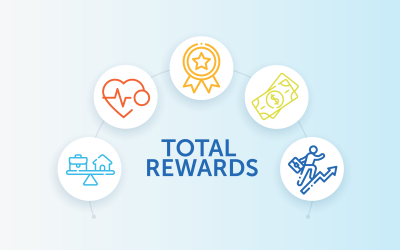Although the wave of employee turnover known as the Great Resignation seems to be fading into the rearview mirror, managing separations remains a significant challenge for businesses. In 2023, approximately 2.5% of U.S. employees quit each month.
Look deeper and this statistic brings up a critical issue: not only does turnover disrupt operations and morale, it also carries a financial burden. The expense of hiring a new employee can be sizable, with hard costs estimated around $4,700, plus up to three to four times salary in soft costs like leadership and management time spent on recruiting and onboarding new hires and the loss of productivity as existing employees backfill the vacant role.
The benefits of lowering turnover are apparent, and today’s advanced people analytics offer the data you need to take action. Here’s how to leverage predictive analytics to better understand your organization’s turnover and make improvements.
How to deploy predictive analytics to understand turnover
The first step in using predictive analytics to analyze employee turnover rates is to define your at-risk cohort. This begins by analyzing historical data from your workforce to identify common trends of employees who quit as well as employees who stay with your organization. You’re looking for patterns and characteristics. Sometimes, these are personal attributes like education, commuting time, use of childcare, and student loan debt.
More often, though, the factors affecting turnover rates are found within your organization itself. These include job satisfaction, compensation (which is not solely about wages but also benefits that meet employees’ needs), tenure, career development opportunities, flexibility and work-life balance, performance, engagement, and managerial support.
Analyzing these elements through predictive analytics allows you to identify current flight risk employees. Predictive models developed from this employee turnover analysis can flag employees who share similar characteristics with those who have previously left, effectively indicating a higher likelihood of turnover. Factors such as decreased job satisfaction, stagnant career development, lack of engagement, or inadequate managerial support are indicators that an employee might be considering leaving.
Of course, some amount of turnover is natural and expected in any organization. Experts recommend focusing on critical and high-performing employees with a medium to high flight risk in order to make the cost/benefit analysis of interventions work in your favor. In other words, it’s inefficient to spend money on targeted interventions for entry-level employees who are easier and less expensive to replace. Higher-level employees often possess unique skills, extensive industry knowledge, or occupy roles that are pivotal to the company’s operations and goals. Their departure can not only disrupt workflow, but also have a long-lasting impact on the team’s morale and the organization’s market position.
So how do you identify these high-value employees? Performance metrics and sales targets are only one part of the equation; also think about how employees embody the company culture (i.e., Are they role models to their peers? Do they demonstrate a positive attitude and resilience?), their ability to drive innovation and growth, and their communication skills. To accurately identify these individuals, organizations can use performance management analytics, peer feedback, and direct observation.
Using people analytics to spotlight high performers allows businesses to direct their retention efforts more strategically, offering personalized development programs, raises or bonuses, and meaningful recognition to those who provide the most value. Underperformers or those less aligned with the company’s goals can be let go, ultimately leading to a more engaged and productive workplace.
Expert tips on using predictive analytics to improve turnover
Now that you know the basics of using employee retention analytics to lower turnover rates, here are some additional pointers from experts in the field.
1. Avoid the appearance of (or actual) discrimination
When looking for commonalities in employee populations, it can be a slippery slope to discrimination. Avoid focusing on demographics, as this can have legal and ethical ramifications. Instead, examining factors such as job satisfaction, career development opportunities, and managerial support helps ensure that predictive analytics practices do not inadvertently contribute to discrimination. This approach gives you actionable ideas for improvement and also fosters a culture of fairness, inclusion, and equity.
2. Take a 360 degree view
Consolidate your data, including business performance, workplace monitoring, and employee sentiment data, to truly understand how different factors interact and influence employee decisions to stay or leave.
For example, business performance data may shed light on the company’s economic stability and growth prospects, which affect job security. Workplace monitoring can reveal patterns in work habits, productivity levels, and collaboration among teams, while employee sentiment analysis from surveys or feedback platforms offers insights into morale, satisfaction, and engagement. Taking a step back and bringing a number of different data types to your employee retention analytics process allows for a more nuanced look at your workplace environment and its impact on talent management.
3. Know the importance of data quality—and keep it secure
The data you use for predictive analytics is the foundation on which you build your HR strategies. Beginning with faulty data is like building a house on sand. High-quality data is accurate, comprehensive, and current, which allows for better predictions and insights into employee turnover risks.
Additionally, securing this data is critical to protecting employee privacy and maintaining trust within the organization. While vendors have a core responsibility to provide security controls, it is not feasible to achieve 100% security risk mitigation on the vendor’s part alone. As such, customers should establish their own internal controls to complement those of the vendor. These complementary user entity controls are commonly published by the vendor for the customer to implement, providing additional assurance that the highest level of risk mitigation is achieved.
4. Invest in the best people analytics platform
The people analytics platform you choose can ensure both data quality and security. If you’re investing in this technology, you want to be assured that you can trust it as a reliable source of truth for predicting turnover, as well as guiding hiring practices, identifying employees for promotion, etc.
ZeroedIn’s flight risk model consolidates data from disparate sources and formats, then uses machine learning algorithms to identify patterns and factors that are indicative of an employee’s likelihood to leave the company. A case study with a 56,000 employee healthcare service provider demonstrated the effectiveness of our algorithm; ZeroedIn identified employee retention at a remarkable 99.75%.
5. Support employee training and a data-driven culture
Cultivating a data-driven workplace culture and offering ample opportunity for employee trainings are important steps in leveraging predictive analytics for turnover reduction. Don’t hide the fact that you use analytics in making key decisions; instead, make sure employees understand how these analytics work and how they make the workplace more equitable and sustainable. Training programs should be implemented to equip employees, especially managers and HR professionals, with the necessary skills to interpret analytics insights and apply them to develop and execute retention strategies effectively.
The bottom line
Utilizing employee turnover analysis to manage and reduce turnover requires a multifaceted approach, but it all begins with reliable data. When disparate data sources are aggregated and analyzed, you’ll have a single source of truth to guide your retention strategies to keep your valuable employees on the job longer.
To explore how people analytics can be tailored to your organization’s specific needs, connect with ZeroedIn today.




